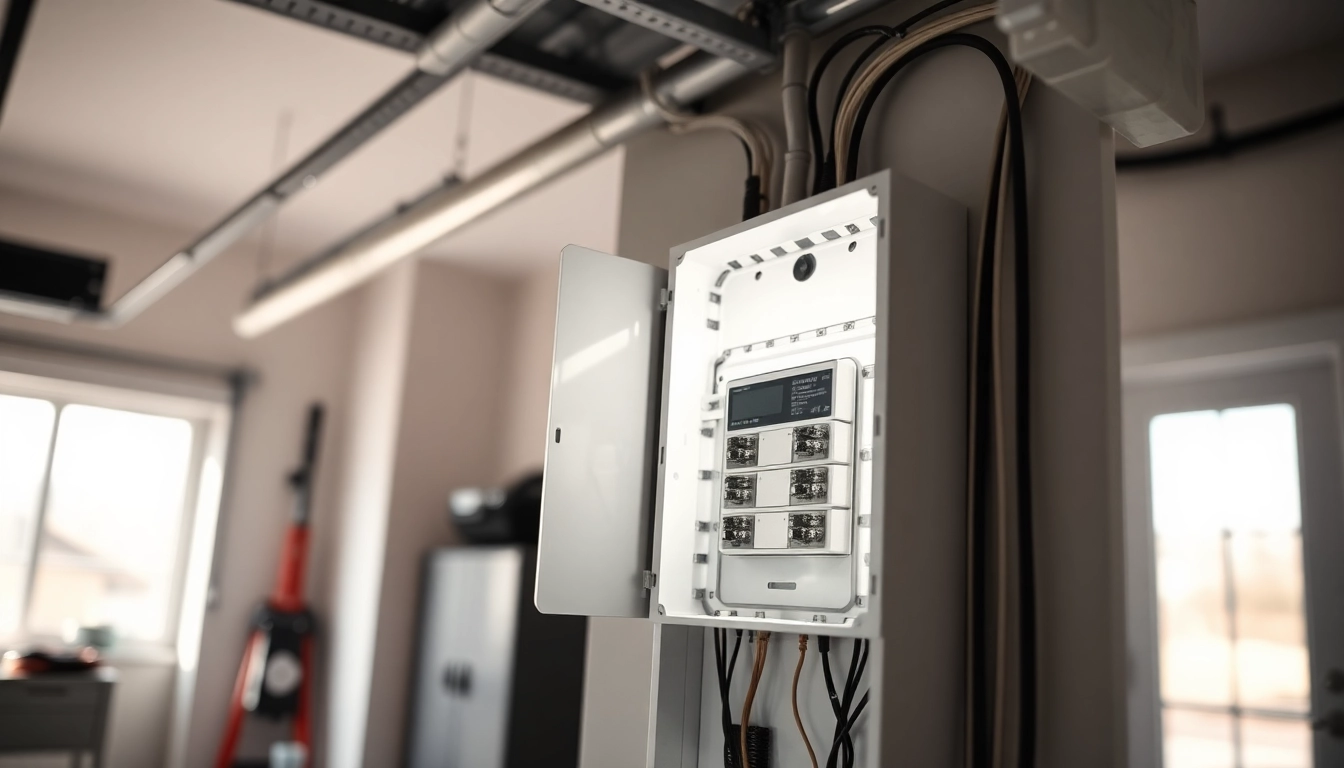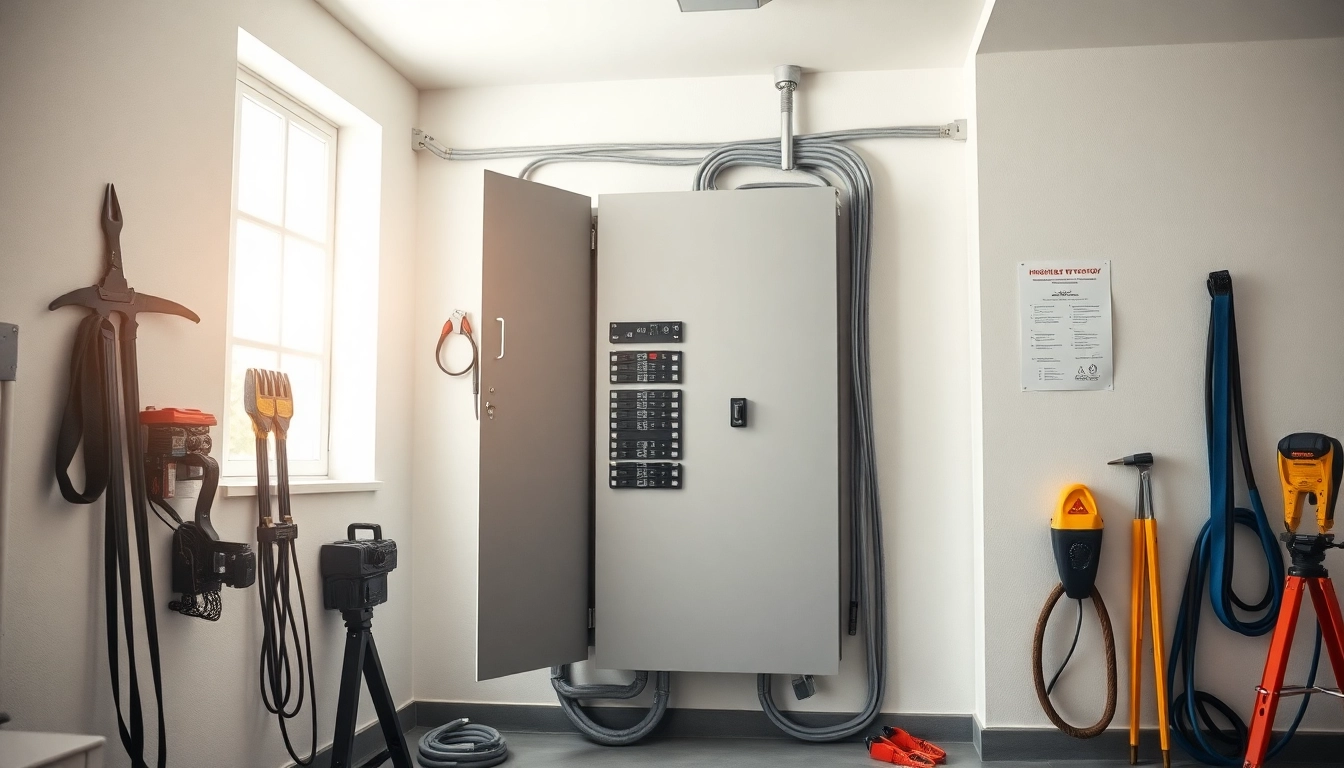
What is an Electrical Panel?
Definition and Purpose of Electrical Panel
An Electrical Panel, often referred to as a breaker box or service panel, is a crucial component of residential and commercial electrical systems. Its primary purpose is to distribute electrical power to various circuits throughout a building. This central hub manages the flow of electricity from the utility company and divides it into separate circuits that provide power to different areas or appliances. Each circuit is protected by a circuit breaker or fuse, preventing electrical overloads and safeguarding the entire electrical system.
Types of Electrical Panel Available
Electrical panels come in several types, each serving specific functions based on the needs of the building. The most common types include:
- Main Breaker Panel: This type contains the main circuit breaker, which disconnects power to the entire electrical system. It is typically used in residential settings.
- Sub-Panel: A sub-panel is an additional panel that derives power from the main panel, providing electricity to specific areas or appliances, such as a garage or basement.
- Transfer Switch Panel: This panel is used in systems that switch from the utility power grid to a backup generator, ensuring continuous power supply during outages.
- Smart Panels: Smart electrical panels utilize technology to provide real-time monitoring and control over electricity usage, adding efficiency and safety benefits.
Key Components of an Electrical Panel
Understanding the key components of an electrical panel is essential for homeowners and electricians alike. These components include:
- Main Breaker: Controls power to the entire panel and serves as the primary overload protection.
- Circuit Breakers: Automatically trip to cut off power to an overloaded circuit, protecting wiring and appliances.
- Bus Bars: Conduct electricity from the incoming supply to the breakers, organized in a manner to maximize efficiency.
- Neutral Bar: Grounds and neutralizes excess electricity from circuits.
- Cover: Protects the internal components and ensures safety compliance.
When to Consider Upgrading Your Electrical Panel
Signs You Need a Larger Electrical Panel
When evaluating the necessity of an upgraded Electrical Panel, homeowners should be aware of several signs. Common indicators include:
- Frequent Tripping of Breakers: If circuit breakers trip often, it may indicate that the panel is overloaded.
- Old Panel Setup: Panels older than 20 to 30 years may not meet modern electrical demands or safety standards.
- New Appliance Additions: Adding high-energy appliances, such as electric vehicle chargers, may necessitate more power than the existing panel can supply.
- Visible Damage: Rust, burn marks, or other signs of wear can suggest that the panel is malfunctioning or unsafe.
- Insufficient Circuits: If there aren’t enough circuits to handle the load in your home, it’s a clear sign of needing an upgrade.
Benefits of Upgrading Your Electrical Panel
Investing in an updated Electrical Panel comes with numerous benefits:
- Increased Capacity: A larger panel can support more circuits, allowing you to meet higher electrical demands efficiently.
- Enhanced Safety: Upgrading with modern circuit breakers that are less prone to malfunctions can reduce fire risks and improve overall safety.
- Improved Energy Efficiency: Newer panels work more efficiently, helping to lower electricity bills.
- Higher Home Value: An updated electrical system is attractive to prospective buyers, possibly increasing the value of your home.
Common Myths about Electrical Panel Upgrades
There are several myths associated with electrical panel upgrades that may prevent homeowners from taking necessary actions:
- Myth 1: Upgrading is unnecessary if the lights are not flickering.
Reality: Even if there are no noticeable symptoms, an undersized panel can lead to long-term damage. - Myth 2: All upgrades are prohibitively expensive.
Reality: While costs vary, many solutions are budget-friendly in the long term. - Myth 3: DIY upgrades are safe.
Reality: Electrical work should always be performed by licensed professionals to ensure compliance with safety regulations.
How Electrical Panels Function
Understanding Circuit Breakers in Electrical Panel
Circuit breakers are essential safety devices in an Electrical Panel that manage electricity flow and protect the entire system. Each breaker is rated for a specific amperage and prevents overload by tripping when that limit is exceeded. The design of the breaker allows for a quick reset, meaning the power can be restored with a simple flick of the switch.
Power Distribution and Safety Features
The electrical panel functions as a power distribution hub, channeling electricity safely throughout a building. Key safety features include:
- Ground Fault Circuit Interrupters (GFCIs): Automatically cut off power when detecting ground faults to prevent electrocution.
- Arc Fault Circuit Interrupters (AFCIs): Detect arc faults that can lead to fires and trip the circuit.
- Surge Protectors: Protect electrical devices from surges that can damage electronics.
Preventive Maintenance for Your Electrical Panel
Maintaining your Electrical Panel is essential for longevity and safety. Here are some preventive maintenance tips:
- Regular Inspections: Schedule periodic inspections with a certified electrician to check for wear and tear.
- Cleanliness: Keep the area around the panel clean and free of clutter to ensure safety and accessibility.
- Test Breakers: Regularly test circuit breakers to ensure they trip correctly.
- Monitor for Overheating: Check for unusual heat around the panel or breakers that could indicate problems.
Electrical Panel Installation Process
Pre-Installation Considerations for Your Electrical Panel
Before installing a new Electrical Panel, consider the following factors:
- Local Codes and Regulations: Research local building codes, as they dictate specifications for electrical installations.
- Panel Size and Type: Determine the appropriate size and type based on electrical load calculations.
- Placement: Identify a suitable location for the panel that adheres to clearance regulations.
- Permits: Acquire necessary permits from local authorities before beginning the installation.
Step-by-Step Guide to Installing Electrical Panel
Installing an electrical panel involves several critical steps. Below is a simplified step-by-step guide:
- Turn Off Power: Ensure that the main power supply is shut off before beginning any work.
- Remove the Old Panel: Carefully detach the old panel from its mounting.
- Install the New Panel: Secure the new panel in place, ensuring it is level and aligned with local codes.
- Connect Wiring: Route the necessary wiring into the new panel and secure connections according to manufacturer instructions.
- Install Breakers: Add appropriate circuit breakers to the panel without exceeding capacity.
- Test the Panel: Once installed, turn the power back on and test each circuit for proper functionality.
Hiring Professionals vs. DIY for Electrical Panel Installation
The decision to hire a professional electrician or tackle an electrical panel installation as a DIY project depends on several factors:
- Complexity: If the installation involves significant rewiring or compliance with stringent codes, hiring a professional is advisable.
- Experience: Those without experience in electrical work may find the process overwhelming and risk significant safety issues.
- Time Constraints: Professionals can often complete the installation faster and more efficiently than someone unfamiliar with the intricacies of electrical systems.
Cost Factors in Electrical Panel Replacement
Average Costs of an Electrical Panel Upgrade
The cost of upgrading an Electrical Panel can vary widely based on several factors, including:
- Panel Size: Larger panels (200 amps or more) typically cost more than smaller panels (100 amps).
- Labor Costs: The complexity of the installation may dictate higher labor charges, especially if additional work is needed.
- Permits and Inspections: Local regulations may require permits, which can add to the cost.
On average, homeowners can expect to spend between $1,000 and $3,000 for a complete panel upgrade, including parts and labor.
Hidden Costs to Anticipate with Electrical Panel Replacement
While planning for costs, homeowners should also consider potential hidden expenses that may arise during an electrical panel upgrade:
- Upgrades to Wiring: Older wiring may need to be upgraded to accommodate the new panel, adding significant costs.
- Sub-panel Installation: If additional circuits are needed, sub-panels may be necessary, driving up total expenses.
- Inspection Fees: Additional inspections may be required by local authorities before or after installation.
Financing Options for Electrical Panel Upgrades
For homeowners considering an electrical panel upgrade, various financing options may be available to help manage costs:
- Personal Loans: Unsecured personal loans offer a straightforward way to finance home improvement projects, including electrical upgrades.
- Home Equity Loans: Leveraging home equity can provide substantial financing for an electrical panel upgrade.
- Credit Cards: For smaller projects, credit cards can offer an accessible payment option, though interest rates should be carefully considered.







